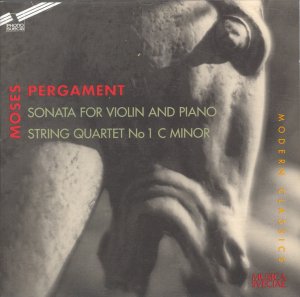Moses
Pergament came of a Jewish family. He was born in Finland. He
was a friend of Sibelius and Pergament's brother, the conductor
Simon Parmet, plays a part in Sibelius's life story. Early on
he absorbed Jewish culture at the synagogue and a Hassidic curve
to the tumult in the long finale of the sonata bear witness to
this. He became a citizen of Sweden in 1919. He revered Wagner.
His living was made through music journalism but he made time
for composition. There are many concert songs but in addition
a string of major works: Krelantems and Eldeling (1920-27),
the choral symphony The Jewish Song (1944), the oratorio
The Seven Deadly Sins (1949), the chamber opera The
Secret of Heaven (1953), the radio opera Eli (1959)
and the unperformed symbolist opera Abrams Erwachen (1966-73).
Pergament's
Violin Sonata is one of those works of the teens of the
century that are caught in full song, Gynt-like playful
reflection and Mephisto grotesquerie. Across three movements it
is in sun-warmed Delian song, continuous and richly accented.
There is no hesitation or preparation of the ground; we are straight
into the tireless flow of song. This is aided by Sparf's febrile
tone. Equivalent works include the violin sonatas by Grieg, Delius,
Rootham, Dunhill, Rootham, Ireland and the earlier ones by Goossens
and Howells. The work is in four movements. The fourth starts
in discord and develops into the rhapsodic and sometimes stormily
double-stopped singing of the first with a fine influx of mid-European
and passion-soaked ghetto flavouring.
Passion
also carries the day in the bursting intensity of the epic Quartet
which has the stormy multi-strata impetus of mid-period Zemlinsky
and early Schoenberg in the first movement. It finds a folksy
repose in the second movement in the form of the somewhat Grainger-like
variations on Det gingo tvá flickor i rosendelund but
even this folksong, squeezed for every drop of sweet 'juice',
is presented as a rhapsody in the attire of expressionism - delicate
and tempestuous. Rather as with the finale of the sonata the final
movement of the quartet incites Pergament to passionate dissonance
but this is of the haunted type that launches from Delius and
Bridge. It then moves into the eldritch tonalities of Bernard
van Dieren and Bridge's late period before gathering itself for
a surprisingly conventional sign-off.
Two
rare, surprising and impressive examples of sunset Delian romanticism
into expressionistic complexity. This disc is an absolute must
if your interests track from Delius, to Van Dieren, to Zemlinsky,
to Schoenberg and Berg.
The
notes are encyclopedically full and the playing matches the considerable
emotional and technical demands of this music.
Rob
Barnett
